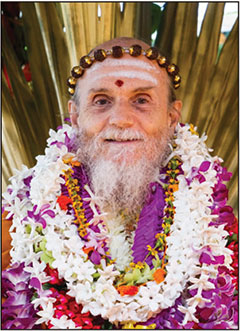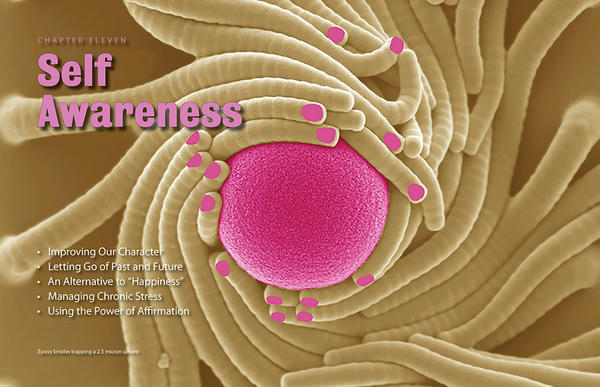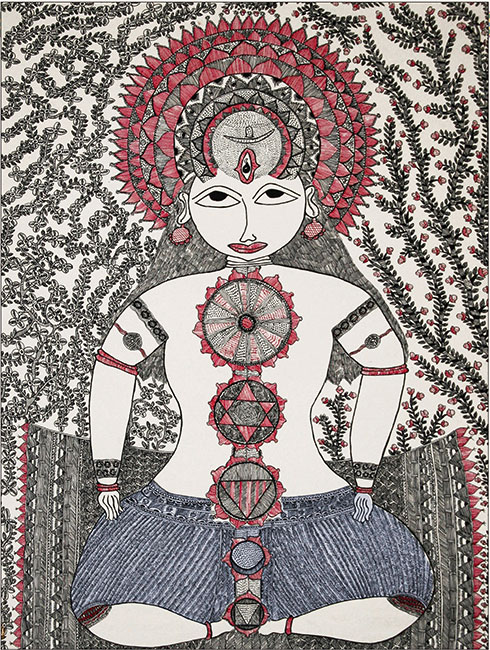PUBLISHER’S DESK • JANUARY 2012§
Improving Our Character
______________________§
If we start at the beginning and work systematically, we can replace undesirable qualities with their opposites§
______________________§
BY SATGURU BODHINATHA VEYLANSWAMI§
 SPIRITUAL LIFE IS NOT DIFFERENT FROM THE rest of life, it is just the best of life. Imagine a woman hears that Ramakrishna saw God as clearly as we see an apple in our hand, or a man hears of great yogis who realize the Truth of the universe in a life-transforming avalanche of light culminating in a sense of the oneness of it all. Seeing this, the man or woman might decide to meditate for days under a tree or in a cave. Or they might fast for days, go on arduous pilgrimages and practice mystic mantras for hours on end. Would they succeed by these efforts? Experience says probably not.§
SPIRITUAL LIFE IS NOT DIFFERENT FROM THE rest of life, it is just the best of life. Imagine a woman hears that Ramakrishna saw God as clearly as we see an apple in our hand, or a man hears of great yogis who realize the Truth of the universe in a life-transforming avalanche of light culminating in a sense of the oneness of it all. Seeing this, the man or woman might decide to meditate for days under a tree or in a cave. Or they might fast for days, go on arduous pilgrimages and practice mystic mantras for hours on end. Would they succeed by these efforts? Experience says probably not.§
Real life offers a key for their journey. Imagine someone who goes to a piano concert and hears the world’s greatest artist. The music is mesmerizing, the pianist’s skill is flawless, soaring, perfect, and our listener decides, “This is my path. This is what I want to do.” He sits at the piano, attempting to equal the master’s work, but great music does not resound. No matter how many hours are spent, no matter how sincere the effort, he cannot achieve what he heard at the concert.§
Why? He does not realize the work required to reach that level of expertise. To be successful, it is vital to start at the beginning of the path, not in the middle or at the end. If the fundamentals are skipped, our efforts will not yield sustainable spiritual progress. In the case of the pianist, the fundamentals are music theory, neural and muscular training, development of memorization, cultivating an interpretive ear and practice, practice, practice. It is no different in spiritual life. The great ones did not sit in a cave and in a short time attain enlightenment. They worked on themselves for years, decades. lifetimes. They did sadhana, they changed their habits, their desires, their reactions, their very character. If we wish to achieve what they achieved, we must do the same. We must work for it.§
The fundamentals, the foundation upon which our spiritual growth rests, is our character. What exactly is character? Character is the sum total of mental and moral qualities distinctive to an individual. On the spiritual path, the first phase of effort is to build, improve and transform our character. My guru, Sivaya Subramuniyaswami, observed:§
“It is true that bliss comes from meditation, and it is true that higher consciousness is the heritage of all mankind. However, the ten restraints [yamas] and their corresponding practices [niyamas] are necessary to maintain bliss consciousness, as well as all of the good feelings toward oneself and others attainable in any incarnation. These restraints and practices build character. Character is the foundation for spiritual unfoldment. The fact is, the higher we go, the lower we can fall. The top chakras spin fast; the lowest one available to us spins even faster. The platform of character must be built within our lifestyle to maintain the total contentment needed to persevere on the path. These great rishis saw the frailty of human nature and gave these guidelines, or disciplines, to make it strong. They said, ‘Strive!’ Let’s strive to not hurt others, to be truthful and honor all the rest of the virtues they outlined.”§
Swami Chinmayananda, founder of Chinmaya Mission, directly related spiritual growth to character transformation: “If we organize our life in such a way so as to discover the great potential within us, and if we order our behavior so as to nurture and nourish that potential, our life will be well spent. Our success lies in the amount of transformation we can bring about in our character and behavior.”§
My guru explained, “To build character, to act in accordance with the yamas, a person has to realize that, having acted instinctively, he experienced consequences that he does not want to experience again; so, now he realizes that he should follow these restraints and not go through those consequences again. This is the foundation; without this foundation there is no spiritual growth, no fruit. Trying to realize the highest realizations before laying this foundation would be like taking a lime tree that was cut off from its roots and putting it into a bucket and expecting it to bear fruit. Of course it will not.”§
Each of us has many character qualities. A character quality is a habit, a usual pattern or way of thinking, speaking or acting. Most people have a mixture of positive character qualities (such as being enthusiastic, punctual, dependable, kindly or sincere) and negative qualities (such as being sarcastic, lazy, tardy or deceptive).§
We have all heard the common excuse for negative character qualities: “That’s the way I am. What can I do about it? I’m simply a lazy person.” Hinduism teaches that the character we are born with in this life is the result of the sum total of our actions in previous lives. Some individuals are clearly pious from birth, others are of a mixed nature and still others are self-centered and devious. However, Hinduism also teaches that we can change the character qualities we are born with through self-reflection and self-effort, by observing and controlling how we think and act in the present, particularly by the repetition of positive thoughts and actions. The more often we express and reflect on the character quality we desire to cultivate, the stronger it will become.§
Accepting the idea that we can change a negative character quality, such as laziness, is a necessary first step. Once that perspective is held, the following four-step approach to developing the opposing positive character quality is helpful:§
1. Understand the positive quality§
2. Cognize its expressions§
3. Realize its benefits§
4. Practice its expressions§
In utilizing this process, we can keep in mind the following principle from Patanjali’s Yoga Sutras: “For the repelling of unwholesome thoughts, their opposites should be cultivated. Unwholesome thoughts, such as harming someone and so forth—whether done, caused to be done, or approved, whether arising from greed, anger or infatuation, whether mild, moderate or extreme—never cease to ripen into ignorance and suffering. This is why one must cultivate their opposites.”§
Let’s see how this four-step process can be utilized to replace laziness with industriousness.§
First: Understand the Positive Quality. Make sure you have a clear understanding of the character quality you wish to cultivate. A good way to approach this is to define it in your own words. Let us define industriousness as “hard-working, willing to work long hours to finish a project.” Its opposite, laziness, is “a disinclination to work hard, preferring to remain idle.” Then meditate on the positive quality.§
Second: Cognize its Expressions. Make a list of thoughts, words, attitudes and behaviors that are representative of people who possess the positive quality. Then make a parallel list for the opposite trait.§
INDUSTRIOUSNESS§ |
LAZINESS§ |
Do the task now |
Postpone the task |
Third: Realize its Benefits. List the benefits of having the quality. This can include insights into the problems caused when its opposite is followed.§
INDUSTRIOUSNESS§
Greater ability to serve family and community§
Opportunities for career advancement§
Appreciation from associates§
Enhanced self-esteem§
Avoid criticism§
Scripture can provide insights. The Tirukural offers valuable thoughts on industriousness, saying, “Good fortune of its own accord ferrets out and finds the man of unflagging energy.” Of laziness it warns: “Procrastination, forgetfulness, sloth and sleep—these four shape the ship bearing those destined for ruin.”§
Fourth: Practice its Expressions: Begin to regularly practice the actions that will develop the habit pattern of the positive character quality. Observe closely, to begin to experience the benefits that result. Set realistic goals. Be careful not to set the goal too high, lest you fall short, become discouraged and give up the effort. For the quality of industriousness, focus on increasing your productivity for the day by five percent. This can be accomplished by working faster, working longer or a combination of both.§
Slowly, character will evolve and the many traits that define you will be transformed, bringing a deeper spirituality and a more secure material existence to your daily life. Remember: Consistency is the key to the conquest of karma.§
PUBLISHER’S DESK • JULY 2010§
Letting Go of Past and Future
______________________§
A peaceful and effective life is waiting for those who undertake the not-so-easy work required to live in the eternal now§
______________________§
BY SATGURU BODHINATHA VEYLANSWAMI§
 MANY INDIVIDUALS FIND THAT WHEN they sit down to meditate their mind is constantly thinking about past and future events. They find that their mental power is seriously dispersed rather than being intensely focused. Though less obvious, this can also happen when we visit a temple. My guru, Sivaya Subramuniyaswami, gives an insightful description of this phenomenon. “How many times have you gone to the temple without being fully there? Part of you was there, part of you was living in the past, part of you was trying to live in the future; and there you were, emoting over the things that happened that should never have happened, and fearful of things that might happen in the future, which probably won’t happen unless you continue being fearful of their happening until you create them!”§
MANY INDIVIDUALS FIND THAT WHEN they sit down to meditate their mind is constantly thinking about past and future events. They find that their mental power is seriously dispersed rather than being intensely focused. Though less obvious, this can also happen when we visit a temple. My guru, Sivaya Subramuniyaswami, gives an insightful description of this phenomenon. “How many times have you gone to the temple without being fully there? Part of you was there, part of you was living in the past, part of you was trying to live in the future; and there you were, emoting over the things that happened that should never have happened, and fearful of things that might happen in the future, which probably won’t happen unless you continue being fearful of their happening until you create them!”§
Focusing the mind, controlling our thoughts, is clearly central to successful meditation. The fact that Patanjali chose this subject for the first sutra of his Yoga Sutras affirms its centrality to the meditative process: “Yoga is restraining the mind stuff from taking various forms.” Beyond helping us be successful in meditation, a focused mind benefits us in other ways. With a focused mind, we will be more successful in our outer activities at work and at school. Another plus is that a focused mind is a peaceful, contented mind. From that peaceful platform we can turn within and more easily contact our intuition, our superconscious mind, the inner voice, and benefit from the wisdom and creativity it provides.§
A good way to measure the level of mental distraction you are experiencing is to walk outdoors with young children. They will always notice many more details of the surroundings than you because their minds are not yet drawn to past and future concerns. Having established the goal—a focused mind, a mind that is not constantly wandering into the past and future—what are some specific techniques we can apply to harness our thoughts?§
Keeping up with the Past: Let’s look first at how we can conquer unnecessary thoughts about the past. Often we think about past events because they are not resolved. They are events that we do not fully understand or accept. Reconciling the past gives freedom and clarity, as Patanjali explained: “As soon as all impurities have been removed by the practice of spiritual disciplines—the limbs of yoga—a man’s spiritual vision opens to the light-giving knowledge of the Atman.”§
It is helpful to distinguish between recent unresolved events and those that happened some time ago. The subconscious mind will for some weeks throw up or present recent events to the conscious mind many times a day. This is a clear indication that an experience is unresolved. After a few weeks, the subconscious will stop its frequent reminders and suppress the experience. Suppressed experiences accumulate in the subconscious, creating an anxious, troubled nature.§
It is good, therefore, to act to resolve each experience while this reminding process is going on rather than to simply wait it out and forget about the happening. It often works to seek a resolution to the matter by discussing it with those involved. If we have hurt the feelings of others, an apology may be appropriate. If our feelings have been hurt, then we may need to forgive others. In such ways, the emotional component of the experience can be defused and the matter resolved.§
Unresolved experiences that happened some time ago will also come to mind, but less frequently than recent ones. It is usually no longer appropriate to apologize or seek apology, as the other parties would not understand why we are bringing up the matter after such a long time. A good alternative is to write down anything from your past that concerns you and burn the paper, holding the intent that the memory will be neutralized. If you are successful with your subconscious journaling, you will still remember, but without the attending emotions.§
Resolving the past may be more of a challenge than one expects. A common problem is an inability to forgive someone—such as an abusive father—for how they treated us. A helpful philosophical approach is to focus on the law of karma by affirming that something we did in the past caused those experiences to come to us in the present. Our father was simply the means through which that karma was experienced. Rather than continuing the unproductive pattern of blaming him, we can inwardly thank him for providing us the opportunity to face our difficult karmas. It is amazing how a simple change in our attitude toward such a thing can transform our reaction to it.§
Reining in the Future: How can we conquer unnecessary thoughts, especially negative anticipations, of the future? Many such thoughts fall into the category of worry. We are concerned that certain events may happen, sometimes to the extent of becoming fearful. A remedy that Gurudeva stressed is to employ a simple affirmation. When the mind starts to worry, say to yourself, “I’m all right, right now.” Keep repeating this affirmation until you are convinced that everything is fine in the present moment.§
Mulling over major decisions is another type of concern about the future. A common practice is to ponder the decision often but without thinking it through and reaching a conclusion, instead jumping each time to another topic. Hence, it becomes a source of worry. An effective way to dispatch the matter is to make a formal appointment with yourself at a time you are free to focus on it fully—for example, 10am on Saturday morning. If you find yourself mulling it over before then, discipline your mind by affirming, “I have an appointment on Saturday to decide this matter, and therefore there is no need to think about it right now.”§
These and other techniques can be used to focus the mind in the present rather than dwelling on the past or the future. Once the strong pulls of past and future have been subdued, we can concentrate on reducing the miscellaneous thoughts about current concerns, such as plans for the day or the news we saw on TV last night. These can be restrained by practicing pranayama, breath control. A simple, effective technique is to breathe in for nine counts, hold for one count, breathe out for nine counts and hold for one count. After breathing in this way for a few minutes, your thinking process will naturally calm down.§
When we manage to center our mind in the present and quiet the cacophony of miscellaneous thoughts, we experience a higher state of consciousness. Gurudeva refers to this as the eternal now: “The mind lives in the past, and the mind tries to live in the future. But when you quiet your mind, you live in the present. You are living within your soul, or the higher state of your mind which is undisturbed by the things of time.”§

S. RAJAM§
Present, past or future?: Three men represent states of mind people dwell in. One lives regretfully in the past, recalling poor childhood days when father drove a bullock cart. Another lives anxiously in the future, worrying about what may come. A third abides in the eternal now, serene, secure and centered.§
The Mountaintop Perspective: One of the abilities available to us once we have freed ourselves of vexations of past and future is to clearly see patterns in our life, and in the lives of others. It is the proverbial state of being able to see the forest instead of the trees. In his early teaching years Gurudeva cultivated this ability by taking his devotees on pilgrimage each month to the top of a nearby mountain from which they could look down on the cities below. This practice was helpful in developing the skill of perceiving the overview.§
An example of a typical mental pattern that can be seen and then improved upon is the habit of making a decision to pursue a project but then giving it up when the first major obstacle is encountered. Once this tendency to quit is perceived, we can work to create a new habit of persevering in our endeavors even when faced with obstacles. A second example is the tendency to make resolves to increase our spiritual practices, sadhanas, but then relinquishing our commitment after spending time with nonreligious friends. This problem can be overcome by spending more time with spiritual friends and less time with naysayers.§
Another benefit that comes from living in the eternal now is the ability to turn within and feel the spiritual power within the spine. There is a dynamic force there that, when experienced, gives us renewed inspiration and positiveness. When we are feeling a bit discouraged, we can find new energy and enthusiasm to meet the tasks at hand by quieting our thoughts and tuning in to this spiritual force felt along the spine.§
Let me share a final insight from Gurudeva on experiencing the eternal now: “Can you visualize yourself, right at this instant, balanced on the top of a tall tree? If the tree were to bend too far forward, you would fall to the ground, or down into time and thought. If it were to bend too far back, you would again fall. Balanced on the top of this tree, you can look out over the countryside and enjoy everything you see. But if you stop to think about one thing of the past, you would become so engrossed in what you are thinking about that you again fall to the ground. You find that you cannot live in a thinking consciousness balanced so high. Here you live in the eternal now, with great awareness of what is around you and within you, but with no thought on it.”§
PUBLISHER’S DESK • JANUARY 2017§
An Alternative to “Happiness”
______________________§
A simple practice which internalizes consciousness allows us to find life’s deeper joys and be content in all circumstances§
______________________§
BY SATGURU BODHINATHA VEYLANSWAMI§
 IF ASKED, “IS YOUR LIFE FOCUSED ON PURSUING HAPPINESS?” many people will readily say, “Yes.” If asked, “Have you found and been able to sustain that happiness?” the same people would likely confess they have not. Hinduism directly addresses the fleeting nature of happiness. My guru, Sivaya Subramuniyaswami, stated, “True happiness and freedom cannot be found in the world, for earthly joy is inextricably bound to sorrow, and worldly freedom to bondage.”§
IF ASKED, “IS YOUR LIFE FOCUSED ON PURSUING HAPPINESS?” many people will readily say, “Yes.” If asked, “Have you found and been able to sustain that happiness?” the same people would likely confess they have not. Hinduism directly addresses the fleeting nature of happiness. My guru, Sivaya Subramuniyaswami, stated, “True happiness and freedom cannot be found in the world, for earthly joy is inextricably bound to sorrow, and worldly freedom to bondage.”§
The Mundaka Upanishad (3.11.1-2) presents this truth in a story. “Two birds, united always and known by the same name, closely cling to the same tree. One of them eats the tree’s sweet fruit, while the other looks on without eating.” The bird enjoying the fruit represents the jivatma, the embodied soul, and the bird simply witnessing represents Paramatma, the transcendent Self. The story continues, “While enjoying the fruit, the first bird moans, bewildered by his limitations. But when he beholds the Other, the glorious Lord worshiped by all, he becomes freed from sorrow.”§
In these verses, the Vedas indicate a way to overcome the cycle of joy and sorrow, happiness and sadness that we experience when living in our outer, instinctive/intellectual consciousness. It is overcome by becoming aware of our innate Divinity and abiding in spiritual consciousness. Paramaguru Yogaswami describes this in one of his Natchintanai songs: “Joy and sorrow—both are maya. The atman, never from love divided, is the very form of knowledge. Therefore, these two will not touch you. Can a mirage wash away the earth? At the gracious, holy feet of the true, all-knowing guru, to the limit of your power, let your heart grow soft and melt.”§
Let’s imagine that we can step inside ourself, deep into our spiritual nature. Let’s imagine further that this journey consists of four steps. After taking those four steps, we find ourself immersed in endless inner space, pure awareness and the transcendent source of that awareness. This is the realm of the deepest samadhis. Three steps within take us to the level of brilliant inner light and the possibility of visions of Deities and rishis. Two steps bring us to the level of divine love for all beings. One step inward takes us to a consciousness that is content, creative and intuitive.§
Initially, it could be frustrating to try to take four, three or even two steps within, as we are not yet able to move to those rarefied levels. A more practical approach is to master taking the first step within during our early morning sadhana time and strive to hold that creative consciousness throughout the day. The other steps are always there, awaiting our future mastery.§
The Chakras§
Our analogy of four steps within relates directly to the chakras. These are the nerve plexuses or centers of force and consciousness located along the spine within our inner bodies. There are seven primary chakras. The first three relate to the instinctive/intellectual mind, which is being experienced by the fabled bird who is enjoying the tree’s fruits. The first chakra (located at the base of spine) is the muladhara, which governs memory. The second is the svadhishthana (below the navel), governing the realm of reason. The third is the manipura (solar plexus), the center of willpower. Without going within, it is natural to live our daily life in the confines of these first three chakras, rarely experiencing anything beyond them.§
The fourth chakra, anahata (at the heart), the center of direct cognition, is the realm we experience by taking the first step within. It is referred to in scriptures as the lotus of the heart.§
The fifth chakra, vishuddha (at the throat), the center of divine love, is the realm experienced when we take the second step within. The sixth chakra, ajna (at the third eye), the center of divine sight, is experienced when we take three steps within. The seventh, sahasrara (located at the crown of head), the center of illumination and Godliness, is experienced when we take the fourth step within.§
Let’s explore what we experience when we take that first step and function in the anahata chakra. Gurudeva described it as the realm of artists, inventors, creators of all kinds. Each time you design or create anything, you are bringing the beauty of the within through your nerve system into manifestation. It is a beautiful place to be, and you can be there all of the time by feeling the power in your spine. The minute you feel that radiant energy, you disconnect from instinctive/intellectual consciousness and soar into inner consciousness.§
A few minutes of breath control will help you to feel the energy in the spine. One simple technique is to breathe nine counts in, hold one count, then breathe out nine counts and again hold one count. After a few minutes of this pranayama, become aware of the spine and the spiritual energy within it. Visualize a clear tube in the center of your spine being filled with yellow light coming down from the top of your head. Then inwardly see this pure life force flowing through the spine and out into the nerve system.§
Challenges§
Having begun our day in a consciousness of contentment, creativity and intuition, we soon encounter the many ways that security can be lost. How can we sustain the sublime state we achieved by taking one step within? The most basic requirement is following the yamas, Hinduism’s ethical restraints. Adharmic actions, such as lying and hurting others, disturb the mind and emotions and draw us out into the swirl of external consciousness.§
Not letting disagreements turn into arguments is also crucial. Disagreements are natural, but they should be handled in an intelligent and harmonious way. We must always be willing to compromise to keep discussions from turning into conflicts. Domestic arguments are the most destabilizing. A major cause of such strife is the misguided view that the home is a natural place to let off steam, to vent frustrations that have built up through the day at work or school. For the sake of harmony, we must change that approach and instead consider the home a sanctuary for the entire family, never regarding it as a place where we can upset others with our emotions. Gurudeva insisted that the home “should have an even higher standard of propriety than the office, the factory or the corporate workplace.” To avoid contention in the home, we can choose other ways to throw off stress: walk through a park or along a beach, visit a yoga studio or workout facility or stop to pray at a temple on the way home.§
Contentment & Gratitude§
Every day we are assaulted by a barrage of advertisements promising greater happiness if we acquire whatever they are promoting. This constant enticement presents a major challenge to sustaining a contented consciousness. Fancy new cars, faster computers, attractive clothes—all promise the ever-elusive state of mind called happiness. We can rise above this false allure by holding the perspective that we are content with what we currently have. If we acquire something more, it will not be because we think it will make us happier but because it will benefit our family in a meaningful way.§
Gratitude is an important aspect of holding an inner consciousness. A key to nurturing gratitude is giving thanks for all the good things in our life. We are grateful for our family and friends, grateful for our job or school, grateful for the home we live in, grateful for the wisdom and practices of our religion.§
“I’m All Right, Right Now”§
The affirmation “I’m all right, right now,” a metaphysical tool that Gurudeva gives us in Merging with Siva, is also helpful in sustaining an inner consciousness. It is a way to live in the eternity of the moment, where we feel perfect in the now, with no future to worry about and no past to regret. You can perform this excellent practice now and again throughout the day. Practice it by asking yourself, “Am I not all right, right now, right this instant?” And answer, “I’m all right, right now.” Keep asking and answering until you feel positive, self-assured and centered in the anahata chakra.§
When we look at the world as providing our happiness, life is a constant series of emotional ups and downs. When we derive our contentment from within, life is joyous, and we can share that joy with others.§
PUBLISHER’S DESK • APRIL 2018§
Managing Chronic Stress
______________________§
Almost everyone these days is challenged by the growing intensity of life. Here are some tools to maintain balance.§
______________________§
BY SATGURU BODHINATHA VEYLANSWAMI§
 ON A REGULAR BASIS I MEET HINDUS who, like most of the world, are emotionally distraught and mentally agitated due to the constant stress of their daily activities. This seems to be especially common when both husband and wife are pursuing demanding careers under employers who expect them to perform at exceptional levels for long hours. It is not uncommon to learn that they are also raising two or more children. The daily demands of work and family are more than can realistically fit into a twenty-four hour day. In some instances, after many years of constantly having too much to do on a daily basis, serious stress results.§
ON A REGULAR BASIS I MEET HINDUS who, like most of the world, are emotionally distraught and mentally agitated due to the constant stress of their daily activities. This seems to be especially common when both husband and wife are pursuing demanding careers under employers who expect them to perform at exceptional levels for long hours. It is not uncommon to learn that they are also raising two or more children. The daily demands of work and family are more than can realistically fit into a twenty-four hour day. In some instances, after many years of constantly having too much to do on a daily basis, serious stress results.§
Some types of stress are self-correcting. We are laid off from our job and after being in that situation a few months experience the stress of no monthly income. However, when we find a new job, the stress automatically goes away. A hurricane destroys our home. The stress is immediate and significant but once we have built a new home, it again resolves itself. The incessant demands of daily activities creates a kind of stress that is different, one that no event takes away. In fact, it can grow more intense from year to year. Faced with this kind of chronic stress, it is prudent and healthy to find ways to reduce it.§
My guru, Sivaya Subramuniyaswami, gave a number of helpful practices for stress management. The first was breath control. He wrote: “The mystic’s goal is to control awareness while he is in the conscious mind (the external world)—to know where he is in consciousness. When he finds he is aware in the conscious mind and the five senses have become his ruler, he then controls his awareness within the conscious mind itself. He does this in a number of ways. One way is through the control of breath. Breath is life, and life is breath. Breath is the controlling factor of awareness. Awareness rides on breath. Breath is also a controlling factor of our willpower. A seeker must develop a dynamic will to walk the path of enlightenment, so that he does not stumble or falter, but continues onward no matter how difficult the path seems to be.”§
When it comes to breathing, the fundamental practice is to be sure you are breathing from your diaphragm and not from your chest. This is the natural way to breathe. It is how babies naturally breathe. However, once we take on life’s tensions, the diaphragm tightens and we tend to expand the chest when we breathe. The diaphragm can be felt right below your solar plexus, in the area where the ribs separate. To locate it, place your fingertips on the diaphragm and cough. When your fingers are directly on the diaphragm, they will jump as you cough. An easy way to learn diaphragmatic breathing is to lie on the floor and place a book on your tummy. When you inhale while relaxed, the diaphragm will extend itself downward in the abdomen, causing the book to rise. When you exhale, the diaphragm completely relaxes and the book returns to its starting position. In this way tension is released and stress is reduced. Gurudeva commented on this: “You will experience that when the nerve currents are quieted through diaphragmatic breathing, it is impossible to be frustrated, and it is possible to absorb within yourself, into the great halls of inner learning, into the great vacuum within you, all of your problems, troubles and fears, without having to psychoanalyze them.”§
Once you grasp the basics of diaphragmatic breathing, you can practice it while sitting upright, even in a chair, or when walking. Whenever you need to relax, such as before (and during!) an important meeting or exam, just take one minute to breathe deeply from the diaphragm. A second practice for reducing chronic stress, the yoga break, also involves breathing. Lie on your back on the floor or any flat, firm surface. With arms at your sides, take a deep breath and command your body and mind to relax, to let go of all thoughts and tensions. Visualize yourself floating on a cloud, above all the troubles and turmoils of daily life. With eyes closed, inhale, breathing from the diaphragm while visualizing a powerful light flooding into your solar plexus that fills your body and mind with energy. Exhaling, feel this light energy moving out from the solar plexus into every part of your body, and visualize it expelling all of your thoughts and tensions. Repeat this for five minutes and you will feel less stressful, for as the body relaxes, so does the mind. Gurudeva wrote: “Freedom from worldly tensions is only achieved to the degree in which people are able to control the forces of their own mind. In this control they are able to lean upon the power of their own inner security, found in the eternity of the moment. In that moment, your inner strength is found. So, take your yoga break whenever you feel even a little tired physically, a little nervous, a little distraught. That is the time, not when you have time.”§
A third practice for managing stress is taking time each morning for a short spiritual/religious practice. Gurudeva called this a daily vigil and gave this comment on it: “Devout Hindus perform daily vigil, called sandhya upasana, usually before dawn. This sacred period of puja, japa, chanting, singing, hatha yoga, meditation and scriptural study is the foundation of personal life.” Holding a daily vigil in the morning helps center us and deepen a sense of religiousness for facing the coming day.§
I outlined a simple format for a daily vigil in my January/February/March 2014 Publisher’s Desk entitled “A 10-Minute Spiritual Workout.” It describes an abbreviated daily regimen designed for those who find that today’s busy life allows little or no time for introspection. It is now available with various chants and practices as a free mobile app designed by the monks and entitled “Spiritual Workout.” A fourth practice is that of hatha yoga, a yogic system of bodily postures, asanas, done in specific sequences and with coordinated breathing. Postures range from simple to difficult. The simple ones are sufficient to practice for reducing chronic stress. Gurudeva gave this description of the benefits of hatha yoga: “The purpose of hatha yoga today again is the same—to keep the physical body, emotional body, astral body and mental body harmonious, healthy and happy so that awareness can soar within to the heights of divine realization. Each asana carefully executed, with regulated breathing, the visualization of color and the hearing of the inner sound, slowly unties the knotted vasanas within the subconscious mind and releases awareness from there to mountaintop consciousness. Hatha yoga opens up the consciousness, because when the height of the energy, the zenith, is reached in each posture and we change to the next posture, a small or large adjustment occurs within the physical and astral nerve system.” See the article on hatha yoga in the March 2001 issue of HINDUISM TODAY for details on the system of 24 postures taught by Gurudeva.§
My guru also spoke of a totally different approach, suggesting that we change our relationship with stress, turn its inevitability to our advantage. He counseled, “People are confused about stress these days. There is a solution, and that is a change in consciousness, changing the way we are programmed.... This means accepting stress as a ‘yes-yes,’ not a ‘no-no.’ In the old days, yoga wasn’t just an Indian anti-stress pill. It made the mind and nerve system more intense, not less so. Stress is a natural reaction to intensity. Stress is our teacher, helping us to withstand intensity. Look into the bathroom mirror and mentally say to yourself, ‘Stress is making me strong.’ It really does. Try to believe it. Begin to enjoy stress and the strength that it is giving you. Where would our world leaders, our religious leaders and parliamentarians, be if they did not accept and transcend stress? ... Accomplished businessmen, fantastic athletes, high-strung artists and fine musicians are asking for more. They want it. They thrive on it. They know it is making them perform at a higher level than normal. They know that weaker souls can’t take it, and that gives them a special place in the universe, at the top.”§
Gurudeva gives us our fifth practice: “But you have to handle stress. How do you handle it? Like anything else. You go to God on the inside; you go to God in the temple and finally you get rid of your stress, from the inside out, and you are a better person because of it, because you have had to expand your nerve system. You have had to stretch your nerve system. You have had to use brain cells that you never used before, to stretch out your mind, awaken new capacities. It is not easy.”§
PUBLISHER’S DESK • APRIL 2004§
Using the Power of Affirmation
______________________§
We mold our lives constantly by what we think and say. With positive affirmation, you can harness this creative force to improve your life.§
______________________§
BY SATGURU BODHINATHA VEYLANSWAMI§
 THE IDEA BEHIND AFFIRMATIONS IS THAT through the repetition of positive statements, we can improve our self-concept, make greater progress on the spiritual path and in general increase our magnetism to success. To progress spiritually, a positive self-concept is essential. For this, the use of affirmations can be quite helpful.§
THE IDEA BEHIND AFFIRMATIONS IS THAT through the repetition of positive statements, we can improve our self-concept, make greater progress on the spiritual path and in general increase our magnetism to success. To progress spiritually, a positive self-concept is essential. For this, the use of affirmations can be quite helpful.§
What exactly is a positive self-concept? It is thinking of ourself as a worthy individual deserving of a wonderful life and fully capable of achieving it. Unfortunately, many of us reach adulthood with a negative self-concept, feeling that others are better than we are and life has little to offer. A negative self-concept occurs when, while growing up, we are criticized constantly or cruelly by our parents and teachers. Having a positive concept about our outer self allows us to identify with our spiritual nature so that we truly feel we are a divine being.§
Let’s look for a moment at changing our self-concept from a negative one to a positive one. If our physical body becomes weak due to a serious illness, after the illness is gone everyone knows that we can overcome the resultant physical weakness and, through consistent exercise, regain our normal strength again. If, however, because of difficult experiences our outlook on life has become negative, and we feel that we just can’t be successful, many people assume this is something that cannot be changed. However, just as we can strengthen the body’s muscles through exercise and become fit again, we can also remold the subconscious mind and change its composition through the power of affirmation.§
What exactly is an affirmation? As our Gurudeva, Satguru Sivaya Subramuniyaswami, explains, an affirmation is a series of positive words repeated time and time again in line with a visual concept. Such a statement can be repeated mentally, or preferably verbally, many times a day. The idea is if one feels “I can’t,” he cannot. If he is always criticizing himself and lamenting over what he cannot do, then he can reverse this pattern and change the flow of magnetic mental force, enliven its intensity by saying orally and feeling through all the pores of his body “I can. I will. I am able to accomplish what I plan.” Gurudeva calls this remolding the subconscious and gives useful insights to seekers on how to accomplish this: “My devotees succeed by remolding subconscious magnetic forces. They purge the dross through writing and burning past transgressions and current problems and then use positive affirmations.”§
There is a very important key to being successful in affirmations: when repeating the affirmation, simultaneously think, visualize and feel what the affirmation is manifesting. Think means to consciously be aware of what the affirmation means. Not thinking would be to repeat the affirmation out of habit while thinking about something else. Visualize means to create a mental picture depicting the affirmation. For example, see yourself making a plan to earn extra money to remodel your home. See yourself earning the money and doing the remodeling. Feel means to have the same feeling you will have when this is consistently happening in your life. In the case of the above affirmation, it is the feeling of confidence and success that goes along with being able to accomplish what you plan. You need to feel now how you will feel in the future when you are successful and confident. Until you awaken this feeling, you should not expect the affirmation to work.§
A Daily Affirmation for Families§
We, the Patel (substitute name) family, beseech the grace of Lord Ganesha to manifest His blessings of peace and harmony within our home and to joyfully fulfill the spiritual, social, economic, cultural and educational goals of family life as outlined in Hindu scripture. We dedicate ourselves, individually and together, to our daily worship, spiritual disciplines and study. Knowing that bonding is essential, we hold daily family meetings and weekly gatherings to cooperatively solve problems and create a loving, uplifting atmosphere in which each member develops discipline, responsibility and the spirit of divine service. We remain close-knit and cultivate unity by talking together about the experiences of our day and extend our affection and harmony to other families as well. We take time for training, and we value mistakes as opportunities to learn. To us, the guest is truly God, welcomed and honored with heartfelt hospitality. Through our thoughtfulness, care and compassion, we allow an abundance of gold to accumulate within our home. We give generously of our income and our time to further our religion. We are filled and thrilled with God’s Cosmic Energy, creatively alive and in tune with the universe.§
Why don’t you try this practice for five minutes a day in the morning, at noon and in the evening and see the positive results it produces? Simply repeat out loud the affirmation “I can. I will. I am able to accomplish what I plan” while utilizing the three keys of thinking, visualizing and feeling. During this exercise, you may find yourself feeling “I can’t. I won’t. I am not able.” If that is the case, it shows that there is a strong negative self-concept in the subconscious mind. Therefore, great benefits to your spiritual and material life will occur if this exercise is continued for a long period of time, because it will result in the negative self-concept being replaced by a positive one.§
If you like, a longer affirmation can be used in your daily exercise, such as the following one. When done in the early morning, this affirmation sets a positive mood for the day. “I am now open to a flow of spiritual energy in which I perceive the most worthy course of action for this day. My service, being selfless, opens new doors of supply, making available all of the tools required so that my work will be beautiful, energetic and influential to the highest degree.”§
Here is another affirmation that is more of a purely divine nature that strengthens our identity as a spiritual being. It is most effective when repeated several times before sleep and upon awakening. “I am not my body, mind or emotions. They are but shells of the infinite energy that flows through them all. I am this energy. I am its source.”§
However, as in the saying “Be careful what you wish for,” the power of affirmation needs to be used with wisdom. Affirmations remold the subconscious mind and thereby change our future. Therefore, we need to be careful that the future we are creating is one in which the responsibilities and challenges are within our abilities to successfully handle. It is wiser to choose a future that is a natural step up in life from where we are than one that is many, many steps away from us. For example, it is a natural next step for someone who is renting an apartment to purchase a modest house, while purchasing a mansion would probably be too big a step up to successfully handle.§
For many years, as part of our pre-dawn worship, the monastery has repeated an affirmation. We recite it aloud together. It has been effective in reminding all the monastics of the overview of what we are doing and the importance of integrating the blessings of the Deities into our everyday affairs. A few years ago we developed a similar affirmation for families to repeat together every morning. We have included it in the sidebar, and suggest that all members of your family recite it together each day.§
In conclusion, through repeating positive statements you can improve your self-concept, make greater progress on the spiritual path and in general increase your magnetism to success. Remember, success depends upon utilizing the threefold key—to think about the meaning, create a visualization for this meaning and feel how you will feel when this is consistently happening in your life.§









